Iran attack: How strong is Iran's military?
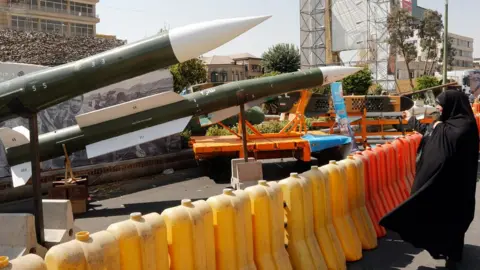 Getty Images
Getty ImagesIran has launched more than a dozen missiles at two bases in Iraq housing US forces.
It had vowed to retaliate after its most powerful military commander, General Qasem Soleimani, was killed by a US drone strike at Baghdad airport.
So what do we know about Iran's military capabilities?
What missiles does Iran have?
Iran's missile systems are a key part of its military arsenal given its relative lack of air power.
Regional rivals such as Israel and Saudi Arabia have the technology to carry out precision air strikes.
Iran largely lacks this capability and so relies on launching missiles.
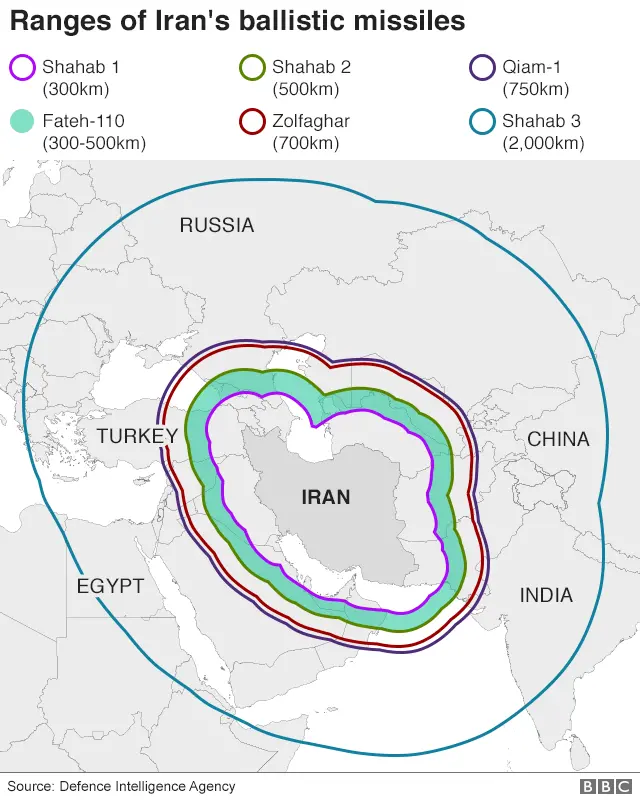

A US Defense Department report describes the country's missile forces as the largest in the Middle East.
It's not possible to give precise figures but the US-based Centre for Strategic and International Studies says Iran has thousands of missiles of more than a dozen different types.
An Iranian media outlet reported that Fateh and Qiam missiles were used in the attack on the US base.
Military analysts have also pointed to the use of these types based on images of the attack sites.
The Qiam-1 missile has been widely produced since 2011, has a range of up 700km and a payload (an indication of how much explosive material it can carry) of 750kg. It was used by Iran against IS fighters in June 2017.
The Fateh class of missiles, which first went into service in the early 2000s, have a slightly lower payload.
The variations of the Shahab-3 intermediate range ballistic missile have payloads of more than 750kg and ranges upwards of 1,500km.
For comparison, a US-built F35 fighter jet has a payload of up to 10,000kg.
Iran has up to 50 medium range ballistic missile launchers and up to 100 short range ballistic missile launchers, according to the International Institute for Strategic Studies, a UK-based think tank.
Iran is also testing space technology to allow it to develop longer range inter-continental missiles, according to the US report.
"Iran has a highly developed missile force with weapons of a variety of ranges" says Jonathan Marcus, the BBC's Defence and diplomatic correspondent.
"They are reasonably accurate - but not as accurate or as reliable as advanced western systems."
The long-range missile programme was put on hold by Iran following the 2015 nuclear deal, according to the Royal United Services Institute (Rusi), but this may now have resumed given the uncertainty surrounding that deal.

In any case, many targets in Saudi Arabia and the Gulf would be within range of Iran's current short and medium-range missiles, and possibly targets in Israel as well.
In May last year, the US deployed a Patriot anti-missile defence system to the Middle East as tensions with Iran increased. This is meant to counter ballistic missiles, cruise missiles and advanced aircraft.
How big is Iran's army?
There are an estimated 523,000 active Iranian personnel, according to the IISS.
This includes 350,000 in the regular army, and at least 150,000 in the Islamic Revolutionary Guards Corps (IRGC).
There are a further 20,000 service personnel in the IRGC's naval forces. This group operates a number of armed patrol boats in the Strait of Hormuz, the site of several confrontations involving foreign-flagged tankers in 2019.
The IRGC also controls the Basij unit, a volunteer force which has helped suppress internal dissent. This unit can potentially mobilise many hundreds of thousands of personnel.
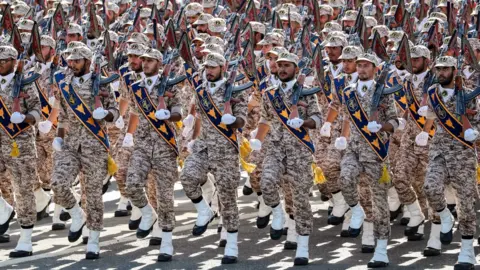 Getty Images
Getty ImagesThe IRGC was set up 40 years ago to defend the Islamic system in Iran and has become a major military, political and economic force in its own right.
Despite having fewer troops than the regular army, it is considered the most authoritative military force in Iran.
What about operations abroad?
The Quds Force, which was led by General Soleimani, conducts secret operations abroad for the IRGC and reports directly to the Supreme Leader of Iran, Ayatollah Ali Khamenei. It's believed to be about 5,000 strong.
The unit has been deployed to Syria, where it advised military elements loyal to Syrian President Bashar al-Assad and armed Shia militias fighting with them. In Iraq, it has supported a Shia-dominated paramilitary force which assisted in the defeat of IS.
However, the US says the Quds force has a wider role by providing funding, training, weapons and equipment to organisations that Washington has designated as terrorist groups in the Middle East. These include Lebanon's Hezbollah movement and the Palestinian Islamic Jihad.
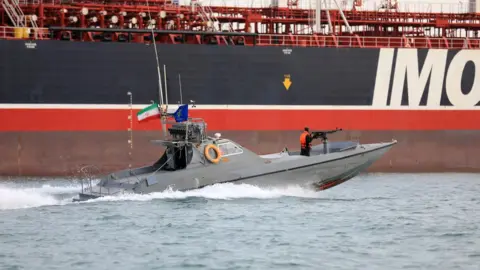 Getty Images
Getty ImagesEconomic problems and sanctions have hampered Iran's arms imports, which are relatively small compared to those of other countries in the region.
The value of Iran's defence imports between 2009 and 2018 was equivalent to just 3.5% of Saudi Arabia's imports over the same period, according to the Stockholm International Peace Research Institute.
Most Iranian imports come from Russia, and the rest from China.
Does Iran have nuclear weapons?
Iran does not currently have a nuclear weapons programme, and has previously said it does not want one. But it does have many of the elements required and the knowledge to create a military nuclear capability.
In 2015, the US government under President Obama estimated that Iran only needed two to three months to produce enough nuclear material to make a weapon.
The nuclear agreement that year between Tehran and six world powers - from which President Trump withdrew in 2018 - introduced limits and international checks on Iran's nuclear activities.
It aimed to make it more difficult and time consuming to develop weapons-grade material.
Following the killing of General Soleimani by US forces, Iran has said it will not be bound by these restrictions. But it also says it will continue to co-operate with the UN's nuclear watchdog, the IAEA.
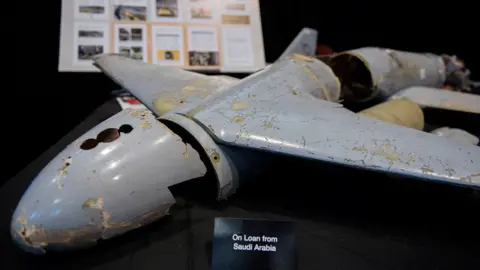 Getty Images
Getty ImagesDespite years of sanctions, Iran has also been able to develop drone capabilities.
In Iraq, Iranian drones have been used since 2016 in the fight against IS. Iran has also entered Israeli airspace with armed drones operated from bases in Syria, according to Rusi.
In June 2019, Iran shot down a US surveillance drone, claiming it had violated Iranian airspace over the Strait of Hormuz.
The other aspect of Iran's drone programme is its willingness to sell or transfer its drone technology to its allies and proxies in the region, says Jonathan Marcus, the BBC's Defence and diplomatic correspondent.
In 2019, drone and missile attacks damaged two key Saudi oil facilities. Both the US and Saudi Arabia linked these attacks to Iran, although Tehran denied any involvement and pointed to a claim of responsibility by rebels in Yemen.
Does Iran have cyber-capabilities?
Following a major cyber-attack in 2010 on Iranian nuclear facilities, Iran ramped up its own cyber-space capability.
The Islamic Revolutionary Guards Corps (IRGC) is believed to have its own cyber-command, working on commercial and military espionage.
In 2012, US officials blamed Iran for a series of cyber attacks on US banks intended to disrupt traffic to their websites.
A US military report in 2019 said Iran had also targeted aerospace companies, defence contractors, energy and natural resource companies and telecommunications firms for cyber-espionage operations around the world.
Also in 2019, Microsoft said a hacker group that "originates from Iran and is linked to the Iranian government" targeted a US presidential campaign and tried to break into the accounts of American government officials.

